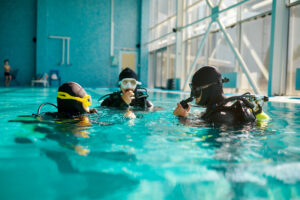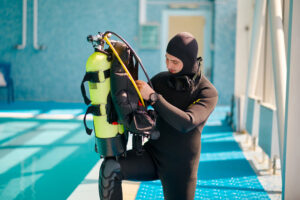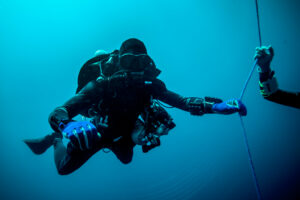What is a Bell Harness?
Scuba diving is a thrilling and captivating sport that offers a unique opportunity to explore the underwater world. As divers traverse the depths, safety becomes paramount, and one essential piece of equipment in certain diving scenarios is the bell harness. This article delves into the design, purpose, and applications of bell harnesses in scuba diving.
Definition and Purpose
A bell harness is a safety harness specifically designed for divers, made from durable webbing material. The harness is worn over the diver’s exposure suit and fastened securely around the body. Its primary function is to provide a safe, secure method of lifting the diver out of the water without the risk of slipping or falling. Bell harnesses are particularly useful in commercial, military, and search and rescue diving operations, where divers are often required to be lifted in and out of the water by surface support vessels or helicopters.
Design and Components
Bell harnesses are constructed using heavy-duty nylon or polyester webbing, chosen for their strength, durability, and resistance to water-related degradation. The harness features a series of adjustable straps, allowing it to fit securely around the diver’s body, regardless of the type or thickness of the exposure suit being worn. Some harnesses also include padding for added comfort, particularly when used in conjunction with heavy gear.
The primary components of a bell harness are
Waist Belt
The waist belt is the central strap that encircles the diver’s waist, usually secured with a quick-release buckle. This belt often features additional D-rings or attachment points for other equipment, such as diving tools, reels, or lights.
Shoulder Straps
These straps run over the diver’s shoulders, connecting the waist belt to the back of the harness. They provide added support and help distribute the weight of the diver and their equipment evenly.
Crotch Strap
The crotch strap runs between the diver’s legs and connects the waist belt at the front to the back of the harness. This strap prevents the harness from riding up and ensures that the diver remains securely fastened during lifting operations.
Lift Point
The lift point is a reinforced attachment point on the back of the harness, typically situated between the shoulder blades. It is designed to connect to a lifting cable, winch, or crane when the diver is being hoisted out of the water.
Quick-release Buckles
These buckles are used to fasten the harness securely around the diver’s body, ensuring a snug fit. They are designed to be easily released in case of an emergency, allowing the diver to quickly remove the harness if necessary.
Applications
Bell harnesses are commonly utilized in various diving operations, including:
Commercial Diving
Commercial divers often work at great depths and must be lifted to the surface using surface-supplied diving systems. Bell harnesses provide a secure method of attaching the diver to the lifting equipment, ensuring that they are not accidentally dropped during the ascent.
Military Diving
In military diving operations, divers may be deployed and retrieved from the water via surface vessels or helicopters. The bell harness enables secure attachment to the lifting mechanism, reducing the risk of injury during these operations.
Search and Rescue Diving
Search and rescue divers are often required to enter and exit the water in challenging conditions, such as rough seas or fast-moving currents. Bell harnesses provide a safe and secure method of lifting these divers, allowing them to focus on the task at hand.
Surface-Supplied Diving
In surface-supplied diving, the diver’s breathing gas is provided from a surface vessel. The bell harness lets the diver connect to a lifting system, ensuring their safe ascent and descent.
Safety Considerations
While bell harnesses provide essential safety benefits in certain diving scenarios, they also come with some safety considerations that divers and surface support personnel should be aware of:
Proper Fit
Ensuring that the bell harness is properly adjusted and snugly fit around the diver’s body is crucial for optimal safety. A poorly adjusted harness can lead to discomfort, restricted movement, or even slipping out during lifting operations.
Equipment Checks
Before each dive, the harness and its components should be carefully inspected for any signs of wear, tear, or damage. Any compromised components must be replaced before the dive to minimize the risk of equipment failure.
Training and Familiarization
Divers and surface support personnel should receive appropriate training in the use and operation of bell harnesses, including proper donning and doffing, lift point attachment, and emergency release procedures.
Clear Communication
Effective communication between the diver and surface support personnel is essential during lifting operations. Divers must be able to signal if they are ready to be lifted or if they encounter any problems during the ascent.
Emergency Procedures
In the event of an emergency, such as entanglement or harness failure, divers and surface support personnel must be prepared to execute appropriate emergency procedures, including the use of quick-release buckles and alternate lifting methods.
Compatibility with Other Equipment
Bell harnesses must be compatible with the diver’s other gear, such as buoyancy control devices (BCDs), drysuits, or rebreathers. Compatibility ensures that the harness does not interfere with the function of other equipment, and divers can easily access essential tools and devices during the dive.
Key Takeaways
Bell harnesses are an indispensable piece of safety equipment for certain diving operations, providing a secure and reliable method of lifting divers in and out of the water. With a robust design, adjustable components, and compatibility with various diving gear, bell harnesses have become an essential tool for commercial, military, and search and rescue divers. By understanding the design, purpose, and applications of bell harnesses, as well as adhering to safety considerations, divers can confidently rely on this equipment to enhance their safety and efficiency during challenging diving scenarios.

















